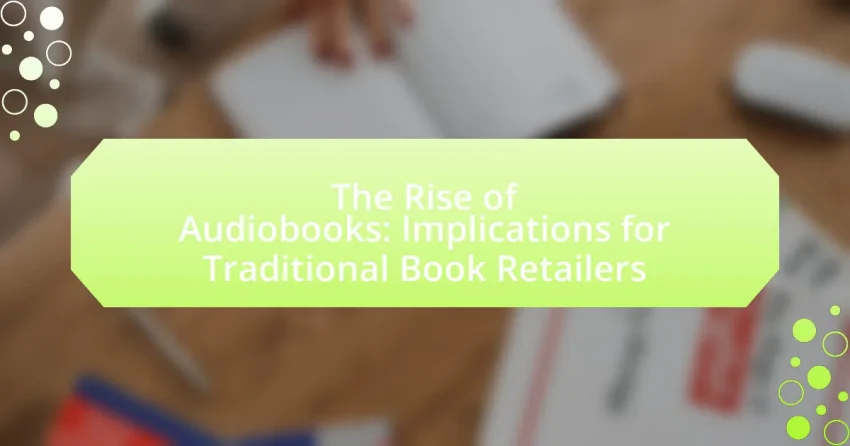Audiobooks, audio recordings of books, are rapidly gaining popularity due to their convenience and the rise of mobile technology, with 50% of Americans aged 12 and older having listened to one as of 2022. This article examines the differences between audiobooks and traditional books, the various formats available, and how audiobooks enhance the reading experience. It also explores the factors contributing to the rise of audiobooks, including technological advancements and changing consumer habits, particularly among younger demographics. Additionally, the implications for traditional book retailers are discussed, highlighting the challenges they face and the strategies they are implementing to adapt to this growing trend. The article concludes with insights into future trends in the audiobook market and best practices for retailers to effectively market and integrate audiobooks into their offerings.

What are Audiobooks and Why are They Gaining Popularity?
Audiobooks are audio recordings of books that allow listeners to consume literature through spoken word rather than reading text. Their popularity is increasing due to factors such as the convenience of multitasking, the rise of mobile technology, and the growing availability of diverse titles across various platforms. According to a 2022 report by the Audio Publishers Association, 50% of Americans aged 12 and older have listened to an audiobook, reflecting a significant rise from previous years. This trend indicates a shift in consumer preferences towards more accessible and flexible reading experiences, particularly among younger demographics who favor digital content.
How do Audiobooks Differ from Traditional Books?
Audiobooks differ from traditional books primarily in their format; audiobooks are audio recordings of text, while traditional books are printed or digital text. This difference in format affects how consumers engage with the content, as audiobooks allow for multitasking and can be consumed while performing other activities, such as driving or exercising. According to a 2021 report by the Audio Publishers Association, 55% of audiobook listeners stated they enjoy the convenience of listening to books during daily tasks, highlighting a significant shift in reading habits. Additionally, audiobooks often feature professional narration, which can enhance the storytelling experience through vocal performance, whereas traditional books rely solely on the reader’s interpretation of the text.
What Formats are Available for Audiobooks?
Audiobooks are available in several formats, including MP3, AAC, WMA, and proprietary formats like Audible’s AAX. MP3 is the most widely used format due to its compatibility with various devices and platforms. AAC offers better sound quality at lower bit rates, making it popular for streaming services. WMA is often used for Windows-based systems, while AAX is specifically designed for Audible’s ecosystem, providing features like chapter navigation and bookmarking. These formats cater to different user preferences and device compatibilities, reflecting the diverse landscape of audiobook consumption.
How Do Audiobooks Enhance the Reading Experience?
Audiobooks enhance the reading experience by providing an immersive and accessible way to consume literature. They allow listeners to engage with stories through narration, which can bring characters and emotions to life, often enhancing comprehension and retention. Research indicates that auditory learning can improve understanding, as demonstrated in a study by the University of California, which found that students who listened to audiobooks performed better on comprehension tests compared to those who read text alone. Additionally, audiobooks offer convenience, enabling multitasking and making literature accessible to individuals with visual impairments or reading difficulties. This versatility contributes to a broader audience engagement, ultimately impacting traditional book retail by expanding the market for literary consumption.
What Factors Contribute to the Rise of Audiobooks?
The rise of audiobooks is primarily driven by advancements in technology, changing consumer habits, and the convenience they offer. Technological improvements, such as the proliferation of smartphones and high-speed internet, have made accessing audiobooks easier than ever. According to a 2021 report by the Audio Publishers Association, 55% of Americans aged 18 and older have listened to an audiobook, reflecting a significant increase from previous years. Additionally, the growing popularity of multitasking and on-the-go lifestyles has led consumers to prefer audiobooks for their ability to be consumed while commuting, exercising, or performing household tasks. This shift in consumer behavior, combined with the increasing availability of diverse audiobook titles and subscription services, has significantly contributed to the medium’s growth.
How Has Technology Influenced Audiobook Accessibility?
Technology has significantly enhanced audiobook accessibility by enabling diverse platforms and devices for consumption. The advent of smartphones and tablets has allowed users to access audiobooks through various apps, such as Audible and Google Play Books, making it easier to listen anytime and anywhere. Additionally, advancements in streaming technology have facilitated instant access to vast libraries of audiobooks without the need for physical media. According to a report by the Audio Publishers Association, the audiobook market grew by 12% in 2020, indicating a rising trend in accessibility and consumption driven by technological innovations. Furthermore, features like adjustable playback speed and text-to-speech capabilities have made audiobooks more user-friendly, catering to different preferences and needs.
What Role Do Streaming Services Play in Audiobook Growth?
Streaming services significantly contribute to audiobook growth by providing easy access to a vast library of titles, which attracts a broader audience. The convenience of streaming allows users to listen to audiobooks on-demand, leading to increased consumption; for instance, the global audiobook market was valued at approximately $3.3 billion in 2020 and is projected to grow at a compound annual growth rate of 25.1% from 2021 to 2028. This surge is partly driven by platforms like Audible and Spotify, which have integrated audiobooks into their offerings, thus enhancing visibility and accessibility. As a result, streaming services not only facilitate audiobook discovery but also encourage habitual listening, further expanding the market.
What Demographics are Driving Audiobook Consumption?
Millennials and Gen Z are the primary demographics driving audiobook consumption. According to a 2021 report by the Audio Publishers Association, 50% of audiobook listeners are aged 18-34, highlighting the significant engagement of younger audiences with this format. Additionally, the convenience of audiobooks aligns with the busy lifestyles of these age groups, as they often multitask while consuming content. This trend is further supported by the rise of smartphone usage, which facilitates easy access to audiobooks through various apps and platforms.
Which Age Groups are Most Likely to Listen to Audiobooks?
Adults aged 18 to 34 are the most likely to listen to audiobooks. According to a 2021 survey by the Audio Publishers Association, 50% of audiobook listeners fall within this age group, indicating a strong preference for audio formats among younger audiences. Additionally, the same survey revealed that 25% of listeners are aged 35 to 54, while only 15% are 55 and older, further emphasizing the trend of younger demographics embracing audiobooks over traditional reading methods.
How Do Listening Habits Vary Across Different Audiences?
Listening habits vary significantly across different audiences due to factors such as age, lifestyle, and technological access. For instance, younger audiences, particularly millennials and Gen Z, tend to prefer audiobooks for their convenience and multitasking capabilities, often listening during commutes or while exercising. In contrast, older audiences may favor traditional reading methods, although they are increasingly adopting audiobooks for ease of access and to accommodate visual impairments. Research from the Audio Publishers Association indicates that 55% of audiobook listeners are under 45, highlighting a demographic shift towards younger audiences who are more engaged with digital content. Additionally, audiences with higher income levels are more likely to invest in audiobooks, as they often have the disposable income to purchase subscriptions or individual titles. This variation in listening habits underscores the need for traditional book retailers to adapt their strategies to cater to diverse audience preferences.

What are the Implications of Audiobooks for Traditional Book Retailers?
Audiobooks significantly impact traditional book retailers by altering consumer purchasing behavior and market dynamics. The rise of audiobooks has led to a shift in how readers consume literature, with a growing preference for audio formats over physical books. According to a 2022 report by the Audio Publishers Association, audiobook sales reached $1.6 billion in the U.S., reflecting a 25% increase from the previous year, indicating a robust market demand that traditional retailers must adapt to.
This shift challenges traditional retailers to diversify their offerings, as consumers increasingly seek convenience and accessibility through digital platforms. Retailers may face declining sales in physical books, necessitating a reevaluation of their business models to incorporate audiobooks, either through partnerships with audiobook platforms or by developing their own digital offerings. Additionally, the competition from online audiobook services can pressure traditional retailers to enhance their in-store experiences and customer engagement strategies to retain market share.
How are Traditional Book Retailers Adapting to the Audiobook Trend?
Traditional book retailers are adapting to the audiobook trend by expanding their offerings to include audiobooks alongside physical books. Many retailers have partnered with audiobook platforms or developed their own digital audiobook services to cater to the growing demand. For instance, Barnes & Noble has launched its own audiobook app, allowing customers to purchase and listen to audiobooks directly. Additionally, retailers are incorporating audiobooks into their marketing strategies, promoting them through in-store displays and online platforms to attract a wider audience. This shift is supported by the fact that the audiobook market has seen significant growth, with revenue reaching over $1.3 billion in 2020, indicating a strong consumer interest that traditional retailers are keen to capitalize on.
What Strategies are Retailers Implementing to Compete?
Retailers are implementing strategies such as diversifying product offerings, enhancing customer experience, and leveraging technology to compete effectively. For instance, many traditional book retailers are expanding their inventory to include audiobooks and e-books, recognizing the growing demand for digital formats. Additionally, retailers are investing in personalized customer experiences through loyalty programs and tailored recommendations, which have been shown to increase customer retention. Furthermore, the integration of technology, such as mobile apps and online platforms, allows retailers to reach a broader audience and streamline the purchasing process, thereby improving sales performance. These strategies are essential for traditional book retailers to adapt to the changing landscape influenced by the rise of audiobooks.
How are Retailers Integrating Audiobooks into Their Offerings?
Retailers are integrating audiobooks into their offerings by expanding their digital platforms to include audiobook sales alongside traditional print and e-book formats. This integration often involves partnerships with audiobook providers, such as Audible or Libro.fm, allowing retailers to offer a wider selection of titles. For instance, major retailers like Barnes & Noble have developed their own audiobook apps, enabling customers to purchase and listen to audiobooks directly from their devices. Additionally, retailers are utilizing subscription models, where customers can pay a monthly fee for access to a library of audiobooks, mirroring successful strategies used in the streaming industry. This shift not only caters to the growing demand for audiobooks—evidenced by a 25% increase in audiobook sales in 2020—but also enhances customer engagement by providing a multi-format shopping experience.
What Challenges Do Traditional Book Retailers Face Due to Audiobooks?
Traditional book retailers face significant challenges due to the rise of audiobooks, primarily in the form of declining physical book sales and changing consumer preferences. As audiobooks gain popularity, many readers opt for the convenience of listening over reading, leading to a decrease in foot traffic and sales in brick-and-mortar stores. According to the Audio Publishers Association, audiobook sales have increased by over 25% annually in recent years, indicating a shift in consumer behavior that traditional retailers must adapt to. Additionally, the competitive pricing and accessibility of audiobooks through subscription services further undermine the traditional retail model, forcing bookstores to rethink their inventory and marketing strategies to remain relevant in a rapidly evolving market.
How Does Pricing Affect the Sales of Audiobooks vs. Print Books?
Pricing significantly influences the sales of audiobooks compared to print books, with lower prices often leading to higher sales volumes for audiobooks. Research indicates that audiobooks are typically priced lower than print books, making them more accessible to a broader audience. For instance, a study by the Audio Publishers Association found that 50% of audiobook listeners reported purchasing more audiobooks when prices were reduced, highlighting the sensitivity of audiobook sales to pricing strategies. In contrast, print books tend to maintain higher price points, which can limit their sales growth, especially in competitive markets. Thus, the pricing strategy directly impacts consumer purchasing behavior, favoring audiobooks when priced competitively.
What Impact Does Audiobook Popularity Have on Physical Book Sales?
Audiobook popularity has a complex impact on physical book sales, often leading to an increase in overall book consumption. Research indicates that consumers who listen to audiobooks are more likely to purchase physical books, as they tend to engage with more titles across formats. A study by the Audio Publishers Association in 2021 found that 61% of audiobook listeners reported buying more print books as a result of their audiobook consumption. This suggests that rather than cannibalizing physical book sales, audiobooks can enhance interest in traditional reading formats, driving sales growth in the book market overall.
What Opportunities Can Audiobooks Present for Traditional Book Retailers?
Audiobooks present significant opportunities for traditional book retailers by expanding their product offerings and attracting a broader customer base. Retailers can leverage the growing popularity of audiobooks, which accounted for over $1.3 billion in sales in 2020, representing a 12% increase from the previous year, according to the Audio Publishers Association. By incorporating audiobooks into their inventory, retailers can enhance customer engagement through bundled promotions, such as offering discounts on physical books when purchased alongside their audiobook counterparts. Additionally, traditional retailers can create exclusive audiobook content or partnerships with authors, further differentiating their offerings in a competitive market. This strategic adaptation not only meets the evolving preferences of consumers but also positions traditional bookstores as versatile hubs for diverse reading experiences.
How Can Retailers Leverage Audiobooks to Attract New Customers?
Retailers can leverage audiobooks to attract new customers by offering exclusive audiobook content and integrating it into their marketing strategies. By providing unique audiobooks or partnerships with popular authors, retailers can create a compelling reason for customers to engage with their brand. For instance, a study by the Audio Publishers Association found that 50% of audiobook listeners are more likely to purchase a print or e-book after listening to the audiobook version. This statistic highlights the potential for retailers to increase overall sales by promoting audiobooks as part of their offerings. Additionally, retailers can utilize social media and email marketing to promote audiobook releases, tapping into the growing audience of audiobook listeners who prefer convenient, on-the-go content consumption.
What Partnerships Can Enhance Audiobook Offerings for Retailers?
Partnerships with audiobook platforms, publishers, and technology providers can significantly enhance audiobook offerings for retailers. Collaborating with established audiobook platforms like Audible or Google Play Books allows retailers to access a vast library of titles, increasing their inventory without the need for extensive investment. Additionally, partnerships with publishers can facilitate exclusive content deals, providing unique audiobooks that attract customers. Collaborating with technology providers can improve the user experience through better app integration and features, such as personalized recommendations and seamless playback. These strategic alliances not only expand the product range but also enhance customer engagement and satisfaction, ultimately driving sales.

What Future Trends Can We Expect in the Audiobook Market?
The audiobook market is expected to see significant growth driven by advancements in technology and changing consumer preferences. As of 2023, the global audiobook market is projected to reach approximately $35 billion by 2030, reflecting a compound annual growth rate (CAGR) of around 25%. This growth is fueled by the increasing popularity of mobile devices and streaming services, which facilitate easy access to audiobooks. Additionally, the rise of subscription models, such as Audible and Scribd, is transforming how consumers engage with audiobooks, making them more accessible and affordable. Furthermore, the integration of artificial intelligence in audiobook production is enhancing the quality and personalization of content, catering to diverse listener preferences. These trends indicate a robust future for the audiobook market, impacting traditional book retailers by shifting consumer spending towards digital formats.
How Will Technology Continue to Shape the Audiobook Industry?
Technology will continue to shape the audiobook industry through advancements in artificial intelligence, improved distribution platforms, and enhanced user experiences. AI-driven narration technologies, such as text-to-speech systems, are becoming increasingly sophisticated, allowing for more natural-sounding voices and personalized listening experiences. For instance, companies like Google and Amazon have developed AI tools that can produce high-quality audiobooks at a fraction of the cost and time compared to traditional narration methods. Additionally, the rise of streaming services and subscription models, exemplified by platforms like Audible and Spotify, has transformed how consumers access and consume audiobooks, leading to increased market growth. According to the Audio Publishers Association, the audiobook market grew by 25% in 2020, highlighting the impact of these technological advancements on consumer behavior and industry dynamics.
What Innovations are on the Horizon for Audiobook Formats?
Innovations on the horizon for audiobook formats include enhanced interactivity, personalized listening experiences, and integration of artificial intelligence for dynamic narration. Enhanced interactivity allows listeners to engage with content through features like branching narratives, where choices affect the storyline. Personalized listening experiences utilize algorithms to recommend titles based on user preferences and listening habits. Additionally, AI-driven dynamic narration can adapt voice modulation and pacing to match the emotional tone of the content, improving listener engagement. These advancements are supported by trends in technology adoption, such as the increasing use of machine learning in content delivery and user experience optimization.
How Might Consumer Preferences Evolve in the Coming Years?
Consumer preferences are likely to evolve towards a greater acceptance and demand for audiobooks in the coming years. This shift is driven by the increasing convenience of consuming content on-the-go, as evidenced by a 2022 report from the Audio Publishers Association, which indicated that 50% of Americans aged 18 and older have listened to an audiobook, up from 44% in 2021. Additionally, the rise of smart speakers and mobile devices facilitates easy access to audiobooks, further influencing consumer behavior. As a result, traditional book retailers may need to adapt their business models to incorporate audiobook offerings to meet this changing demand.
What Best Practices Should Traditional Book Retailers Consider for Audiobooks?
Traditional book retailers should prioritize integrating audiobooks into their offerings by establishing partnerships with audiobook platforms and enhancing in-store experiences. By collaborating with platforms like Audible or Libro.fm, retailers can expand their inventory and reach a broader audience, as the audiobook market has seen significant growth, with sales increasing by 12% in 2020 alone, according to the Audio Publishers Association. Additionally, creating dedicated audiobook sections in stores and hosting listening events can engage customers and promote the format effectively. This approach not only diversifies product offerings but also aligns with consumer trends favoring digital formats, thereby increasing overall sales and customer satisfaction.
How Can Retailers Effectively Market Audiobooks to Their Audience?
Retailers can effectively market audiobooks to their audience by leveraging targeted digital marketing strategies, such as social media advertising, email campaigns, and partnerships with influencers. These strategies allow retailers to reach specific demographics that are more likely to engage with audiobooks, such as busy professionals and commuters. For instance, a study by the Audio Publishers Association found that 55% of audiobook listeners are under 35 years old, indicating a younger audience that can be effectively targeted through platforms like Instagram and TikTok. Additionally, offering promotions, such as free trials or discounts on first purchases, can incentivize new customers to explore audiobooks. Retailers can also enhance visibility by curating personalized recommendations based on user preferences, which can increase engagement and sales.
What Role Does Customer Feedback Play in Audiobook Selection?
Customer feedback plays a crucial role in audiobook selection by influencing both consumer choices and publisher decisions. Positive reviews and ratings can significantly boost an audiobook’s visibility and sales, as consumers often rely on the experiences of others to guide their purchasing decisions. For instance, a study by the Pew Research Center found that 70% of audiobook listeners consider reviews important when selecting titles. Additionally, publishers analyze feedback to identify trends and preferences, allowing them to curate content that aligns with listener interests, ultimately shaping the audiobook market.
